Impacts of Strong HR in Mercedes Benz, London: Research Proposal
VerifiedAdded on 2023/06/10
|23
|5208
|99
Report
AI Summary
This research proposal examines the impacts of a strong Human Resource (HR) department on Mercedes Benz, specifically focusing on its operations in London. The study begins with an introduction highlighting the increasing dynamics of the global business environment and the importance of efficient HR management for organizational success. It then explores the research background, emphasizing Mercedes Benz's challenges in a competitive market. The research objectives include analyzing Mercedes Benz's performance, examining HR practices, and assessing their implications on employees and the company. The methodology section outlines the research approach, methods, data collection, and analysis techniques, including limitations and ethical considerations. The literature review provides a comprehensive overview of HR management, defining key terms, exploring its functions, and discussing the impacts of strong HR practices. The proposal aims to answer key research questions about HR's influence on Mercedes Benz's performance, employee satisfaction, and overall operations. The proposal includes an ethical checklist and references to support the study.
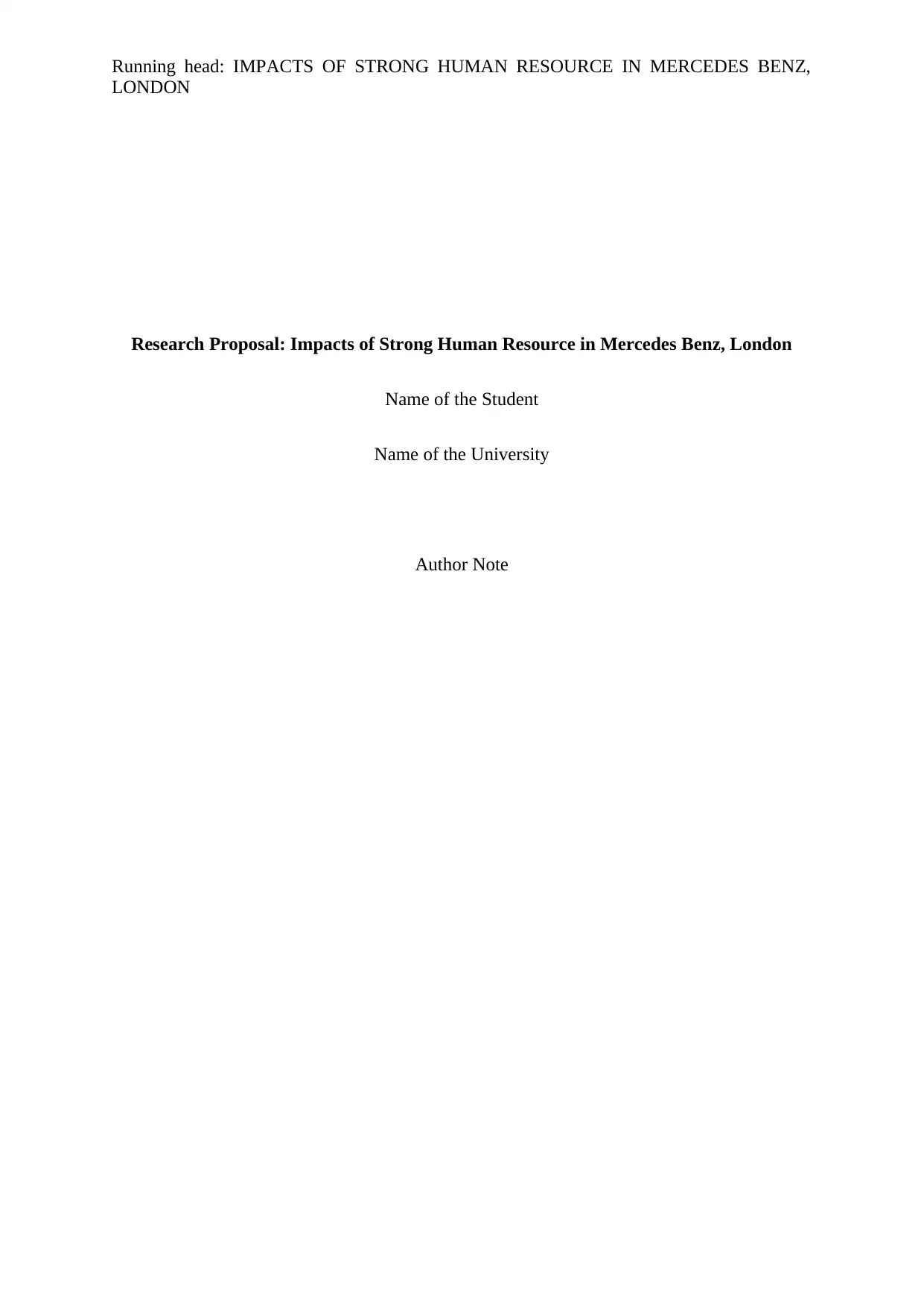
Running head: IMPACTS OF STRONG HUMAN RESOURCE IN MERCEDES BENZ,
LONDON
Research Proposal: Impacts of Strong Human Resource in Mercedes Benz, London
Name of the Student
Name of the University
Author Note
LONDON
Research Proposal: Impacts of Strong Human Resource in Mercedes Benz, London
Name of the Student
Name of the University
Author Note
Paraphrase This Document
Need a fresh take? Get an instant paraphrase of this document with our AI Paraphraser
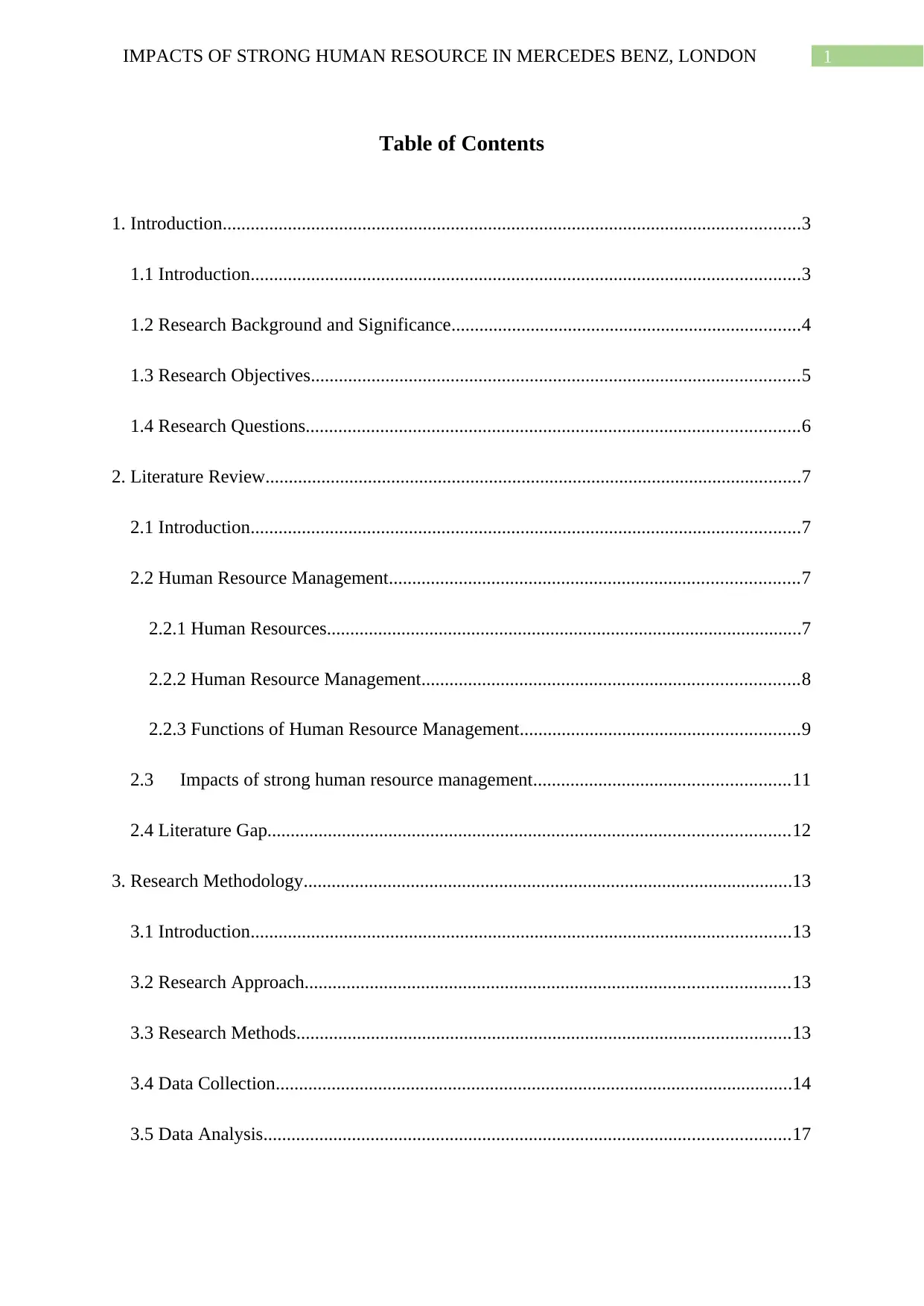
1IMPACTS OF STRONG HUMAN RESOURCE IN MERCEDES BENZ, LONDON
Table of Contents
1. Introduction............................................................................................................................3
1.1 Introduction......................................................................................................................3
1.2 Research Background and Significance...........................................................................4
1.3 Research Objectives.........................................................................................................5
1.4 Research Questions..........................................................................................................6
2. Literature Review...................................................................................................................7
2.1 Introduction......................................................................................................................7
2.2 Human Resource Management........................................................................................7
2.2.1 Human Resources......................................................................................................7
2.2.2 Human Resource Management.................................................................................8
2.2.3 Functions of Human Resource Management............................................................9
2.3 Impacts of strong human resource management.......................................................11
2.4 Literature Gap................................................................................................................12
3. Research Methodology.........................................................................................................13
3.1 Introduction....................................................................................................................13
3.2 Research Approach........................................................................................................13
3.3 Research Methods..........................................................................................................13
3.4 Data Collection...............................................................................................................14
3.5 Data Analysis.................................................................................................................17
Table of Contents
1. Introduction............................................................................................................................3
1.1 Introduction......................................................................................................................3
1.2 Research Background and Significance...........................................................................4
1.3 Research Objectives.........................................................................................................5
1.4 Research Questions..........................................................................................................6
2. Literature Review...................................................................................................................7
2.1 Introduction......................................................................................................................7
2.2 Human Resource Management........................................................................................7
2.2.1 Human Resources......................................................................................................7
2.2.2 Human Resource Management.................................................................................8
2.2.3 Functions of Human Resource Management............................................................9
2.3 Impacts of strong human resource management.......................................................11
2.4 Literature Gap................................................................................................................12
3. Research Methodology.........................................................................................................13
3.1 Introduction....................................................................................................................13
3.2 Research Approach........................................................................................................13
3.3 Research Methods..........................................................................................................13
3.4 Data Collection...............................................................................................................14
3.5 Data Analysis.................................................................................................................17
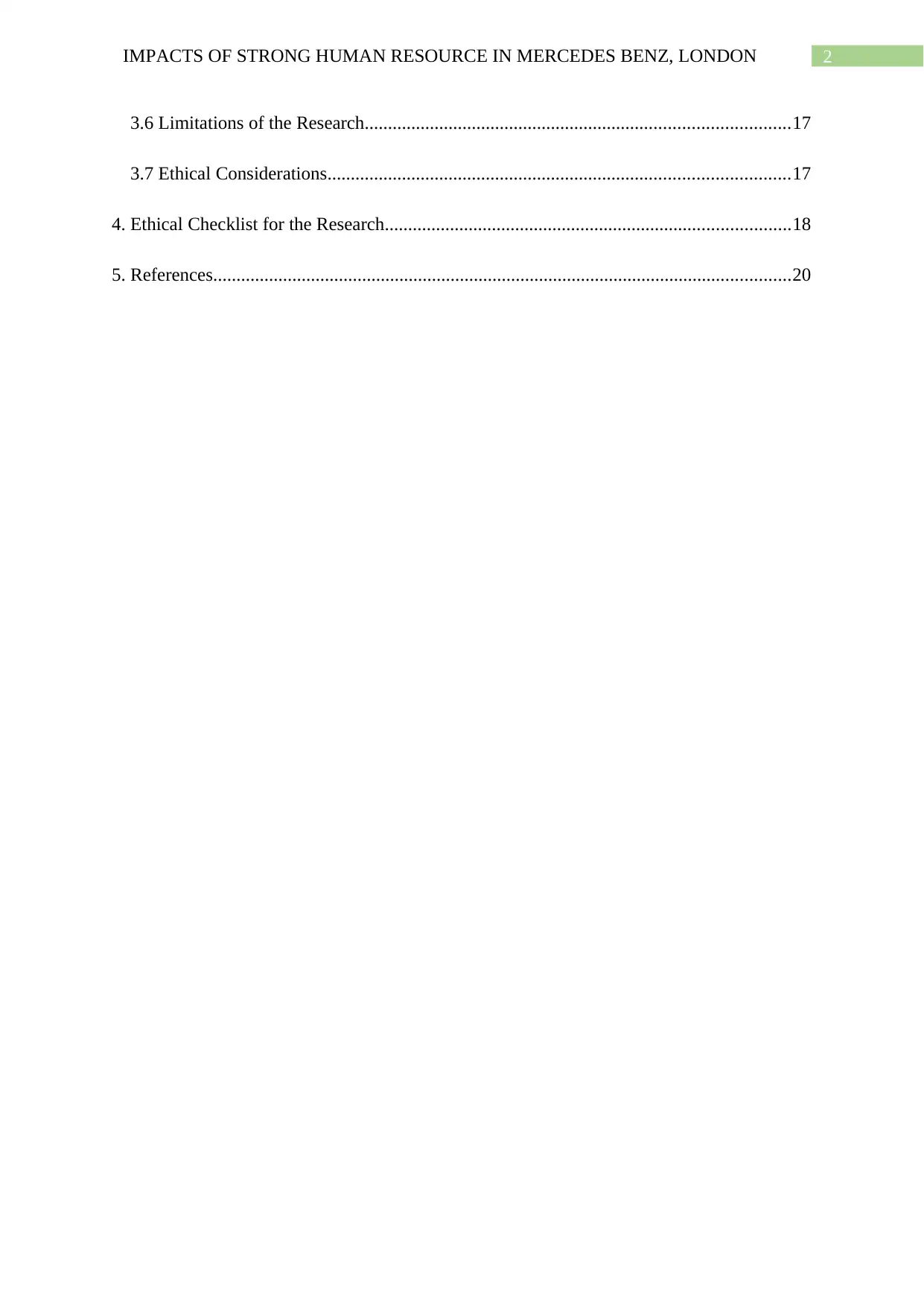
2IMPACTS OF STRONG HUMAN RESOURCE IN MERCEDES BENZ, LONDON
3.6 Limitations of the Research...........................................................................................17
3.7 Ethical Considerations...................................................................................................17
4. Ethical Checklist for the Research.......................................................................................18
5. References............................................................................................................................20
3.6 Limitations of the Research...........................................................................................17
3.7 Ethical Considerations...................................................................................................17
4. Ethical Checklist for the Research.......................................................................................18
5. References............................................................................................................................20
⊘ This is a preview!⊘
Do you want full access?
Subscribe today to unlock all pages.

Trusted by 1+ million students worldwide
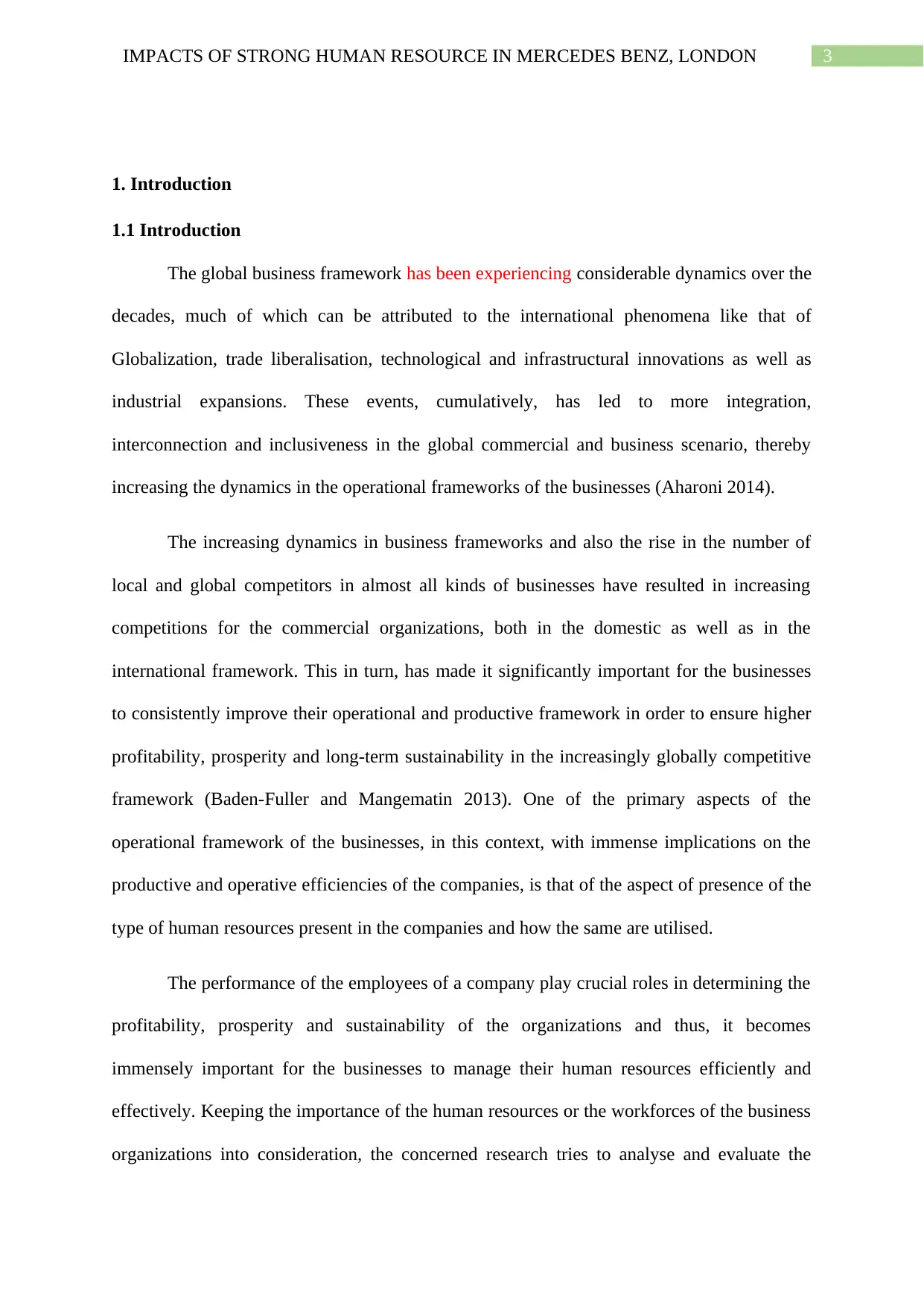
3IMPACTS OF STRONG HUMAN RESOURCE IN MERCEDES BENZ, LONDON
1. Introduction
1.1 Introduction
The global business framework has been experiencing considerable dynamics over the
decades, much of which can be attributed to the international phenomena like that of
Globalization, trade liberalisation, technological and infrastructural innovations as well as
industrial expansions. These events, cumulatively, has led to more integration,
interconnection and inclusiveness in the global commercial and business scenario, thereby
increasing the dynamics in the operational frameworks of the businesses (Aharoni 2014).
The increasing dynamics in business frameworks and also the rise in the number of
local and global competitors in almost all kinds of businesses have resulted in increasing
competitions for the commercial organizations, both in the domestic as well as in the
international framework. This in turn, has made it significantly important for the businesses
to consistently improve their operational and productive framework in order to ensure higher
profitability, prosperity and long-term sustainability in the increasingly globally competitive
framework (Baden-Fuller and Mangematin 2013). One of the primary aspects of the
operational framework of the businesses, in this context, with immense implications on the
productive and operative efficiencies of the companies, is that of the aspect of presence of the
type of human resources present in the companies and how the same are utilised.
The performance of the employees of a company play crucial roles in determining the
profitability, prosperity and sustainability of the organizations and thus, it becomes
immensely important for the businesses to manage their human resources efficiently and
effectively. Keeping the importance of the human resources or the workforces of the business
organizations into consideration, the concerned research tries to analyse and evaluate the
1. Introduction
1.1 Introduction
The global business framework has been experiencing considerable dynamics over the
decades, much of which can be attributed to the international phenomena like that of
Globalization, trade liberalisation, technological and infrastructural innovations as well as
industrial expansions. These events, cumulatively, has led to more integration,
interconnection and inclusiveness in the global commercial and business scenario, thereby
increasing the dynamics in the operational frameworks of the businesses (Aharoni 2014).
The increasing dynamics in business frameworks and also the rise in the number of
local and global competitors in almost all kinds of businesses have resulted in increasing
competitions for the commercial organizations, both in the domestic as well as in the
international framework. This in turn, has made it significantly important for the businesses
to consistently improve their operational and productive framework in order to ensure higher
profitability, prosperity and long-term sustainability in the increasingly globally competitive
framework (Baden-Fuller and Mangematin 2013). One of the primary aspects of the
operational framework of the businesses, in this context, with immense implications on the
productive and operative efficiencies of the companies, is that of the aspect of presence of the
type of human resources present in the companies and how the same are utilised.
The performance of the employees of a company play crucial roles in determining the
profitability, prosperity and sustainability of the organizations and thus, it becomes
immensely important for the businesses to manage their human resources efficiently and
effectively. Keeping the importance of the human resources or the workforces of the business
organizations into consideration, the concerned research tries to analyse and evaluate the
Paraphrase This Document
Need a fresh take? Get an instant paraphrase of this document with our AI Paraphraser
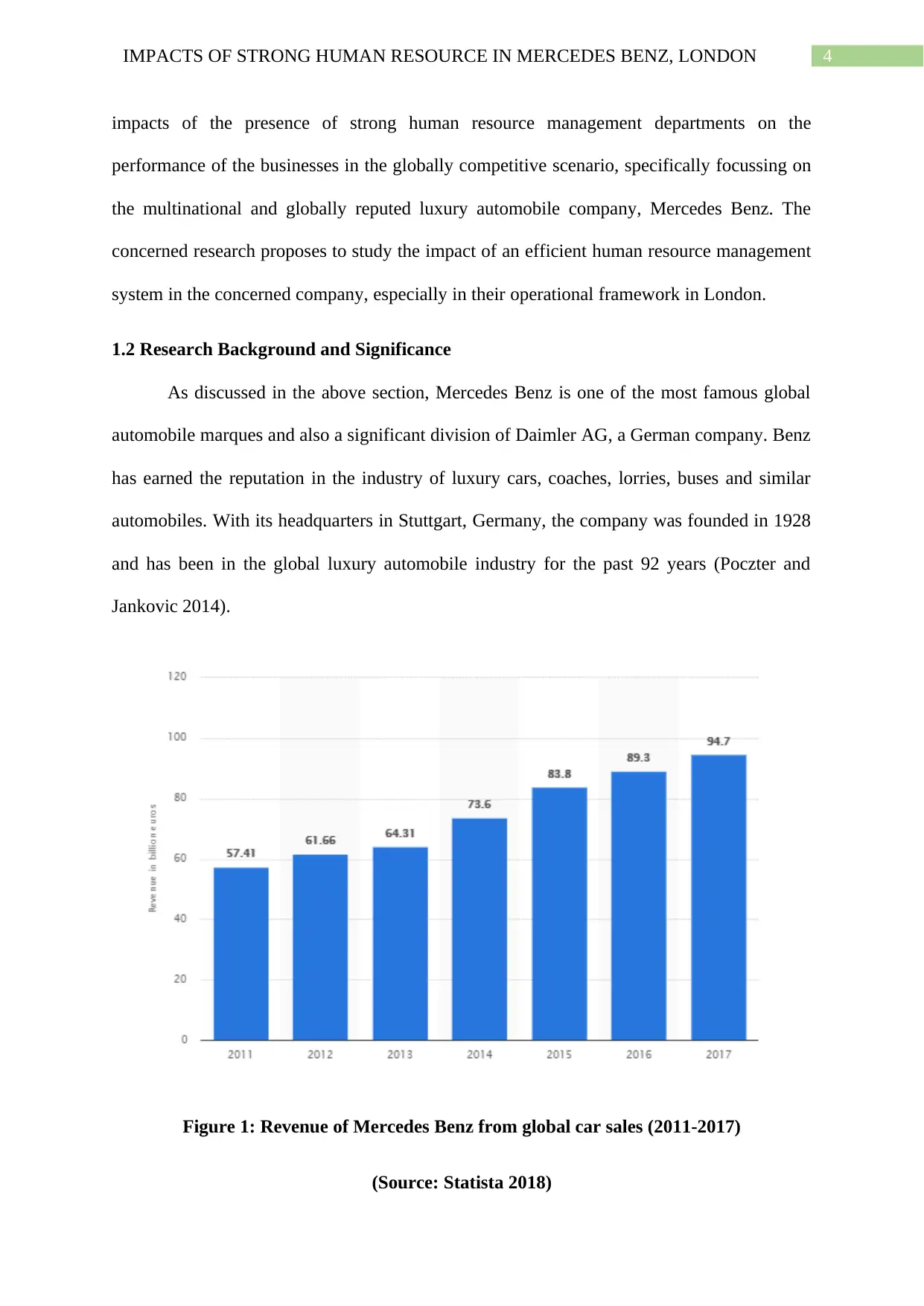
4IMPACTS OF STRONG HUMAN RESOURCE IN MERCEDES BENZ, LONDON
impacts of the presence of strong human resource management departments on the
performance of the businesses in the globally competitive scenario, specifically focussing on
the multinational and globally reputed luxury automobile company, Mercedes Benz. The
concerned research proposes to study the impact of an efficient human resource management
system in the concerned company, especially in their operational framework in London.
1.2 Research Background and Significance
As discussed in the above section, Mercedes Benz is one of the most famous global
automobile marques and also a significant division of Daimler AG, a German company. Benz
has earned the reputation in the industry of luxury cars, coaches, lorries, buses and similar
automobiles. With its headquarters in Stuttgart, Germany, the company was founded in 1928
and has been in the global luxury automobile industry for the past 92 years (Poczter and
Jankovic 2014).
Figure 1: Revenue of Mercedes Benz from global car sales (2011-2017)
(Source: Statista 2018)
impacts of the presence of strong human resource management departments on the
performance of the businesses in the globally competitive scenario, specifically focussing on
the multinational and globally reputed luxury automobile company, Mercedes Benz. The
concerned research proposes to study the impact of an efficient human resource management
system in the concerned company, especially in their operational framework in London.
1.2 Research Background and Significance
As discussed in the above section, Mercedes Benz is one of the most famous global
automobile marques and also a significant division of Daimler AG, a German company. Benz
has earned the reputation in the industry of luxury cars, coaches, lorries, buses and similar
automobiles. With its headquarters in Stuttgart, Germany, the company was founded in 1928
and has been in the global luxury automobile industry for the past 92 years (Poczter and
Jankovic 2014).
Figure 1: Revenue of Mercedes Benz from global car sales (2011-2017)
(Source: Statista 2018)
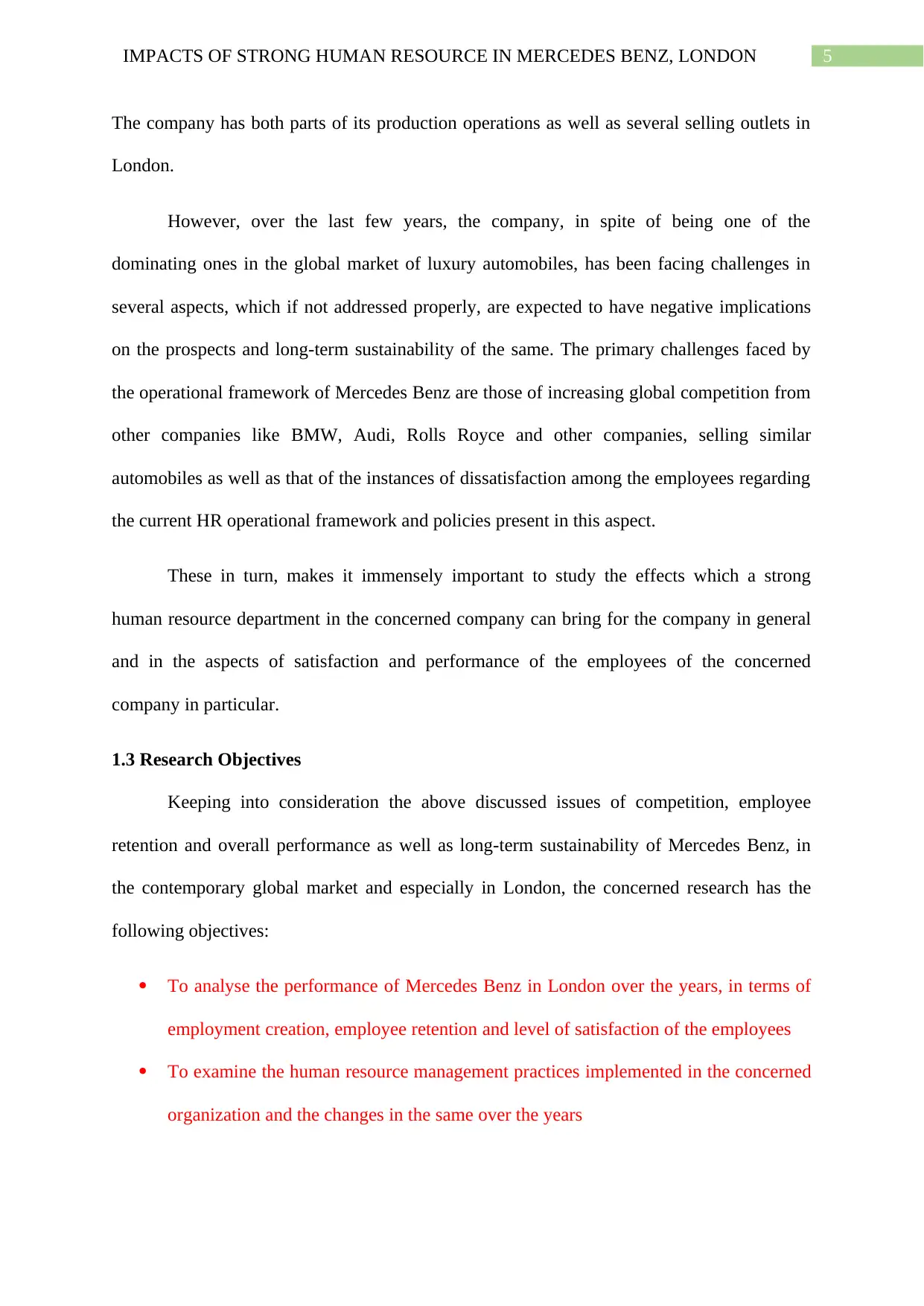
5IMPACTS OF STRONG HUMAN RESOURCE IN MERCEDES BENZ, LONDON
The company has both parts of its production operations as well as several selling outlets in
London.
However, over the last few years, the company, in spite of being one of the
dominating ones in the global market of luxury automobiles, has been facing challenges in
several aspects, which if not addressed properly, are expected to have negative implications
on the prospects and long-term sustainability of the same. The primary challenges faced by
the operational framework of Mercedes Benz are those of increasing global competition from
other companies like BMW, Audi, Rolls Royce and other companies, selling similar
automobiles as well as that of the instances of dissatisfaction among the employees regarding
the current HR operational framework and policies present in this aspect.
These in turn, makes it immensely important to study the effects which a strong
human resource department in the concerned company can bring for the company in general
and in the aspects of satisfaction and performance of the employees of the concerned
company in particular.
1.3 Research Objectives
Keeping into consideration the above discussed issues of competition, employee
retention and overall performance as well as long-term sustainability of Mercedes Benz, in
the contemporary global market and especially in London, the concerned research has the
following objectives:
To analyse the performance of Mercedes Benz in London over the years, in terms of
employment creation, employee retention and level of satisfaction of the employees
To examine the human resource management practices implemented in the concerned
organization and the changes in the same over the years
The company has both parts of its production operations as well as several selling outlets in
London.
However, over the last few years, the company, in spite of being one of the
dominating ones in the global market of luxury automobiles, has been facing challenges in
several aspects, which if not addressed properly, are expected to have negative implications
on the prospects and long-term sustainability of the same. The primary challenges faced by
the operational framework of Mercedes Benz are those of increasing global competition from
other companies like BMW, Audi, Rolls Royce and other companies, selling similar
automobiles as well as that of the instances of dissatisfaction among the employees regarding
the current HR operational framework and policies present in this aspect.
These in turn, makes it immensely important to study the effects which a strong
human resource department in the concerned company can bring for the company in general
and in the aspects of satisfaction and performance of the employees of the concerned
company in particular.
1.3 Research Objectives
Keeping into consideration the above discussed issues of competition, employee
retention and overall performance as well as long-term sustainability of Mercedes Benz, in
the contemporary global market and especially in London, the concerned research has the
following objectives:
To analyse the performance of Mercedes Benz in London over the years, in terms of
employment creation, employee retention and level of satisfaction of the employees
To examine the human resource management practices implemented in the concerned
organization and the changes in the same over the years
⊘ This is a preview!⊘
Do you want full access?
Subscribe today to unlock all pages.

Trusted by 1+ million students worldwide
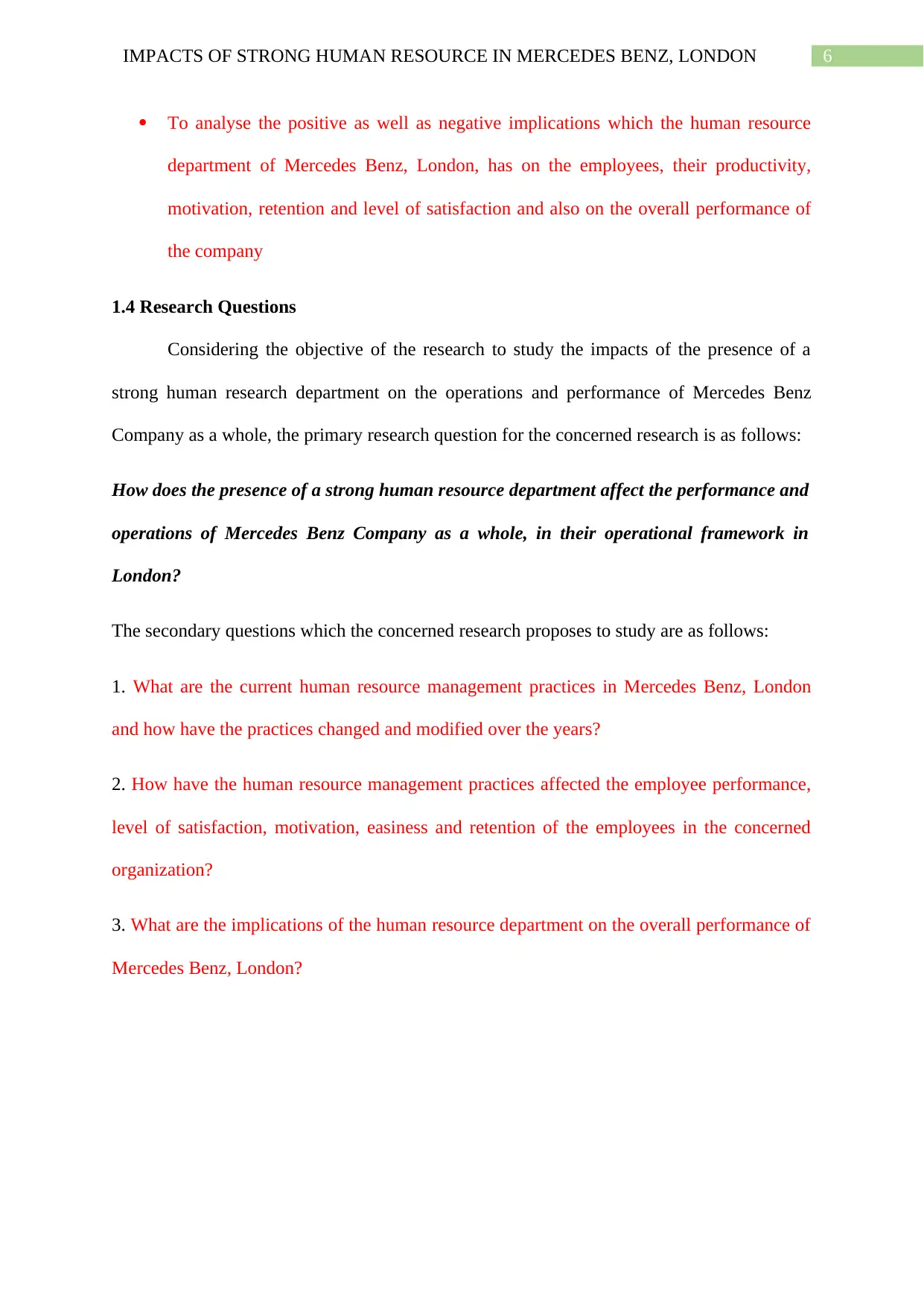
6IMPACTS OF STRONG HUMAN RESOURCE IN MERCEDES BENZ, LONDON
To analyse the positive as well as negative implications which the human resource
department of Mercedes Benz, London, has on the employees, their productivity,
motivation, retention and level of satisfaction and also on the overall performance of
the company
1.4 Research Questions
Considering the objective of the research to study the impacts of the presence of a
strong human research department on the operations and performance of Mercedes Benz
Company as a whole, the primary research question for the concerned research is as follows:
How does the presence of a strong human resource department affect the performance and
operations of Mercedes Benz Company as a whole, in their operational framework in
London?
The secondary questions which the concerned research proposes to study are as follows:
1. What are the current human resource management practices in Mercedes Benz, London
and how have the practices changed and modified over the years?
2. How have the human resource management practices affected the employee performance,
level of satisfaction, motivation, easiness and retention of the employees in the concerned
organization?
3. What are the implications of the human resource department on the overall performance of
Mercedes Benz, London?
To analyse the positive as well as negative implications which the human resource
department of Mercedes Benz, London, has on the employees, their productivity,
motivation, retention and level of satisfaction and also on the overall performance of
the company
1.4 Research Questions
Considering the objective of the research to study the impacts of the presence of a
strong human research department on the operations and performance of Mercedes Benz
Company as a whole, the primary research question for the concerned research is as follows:
How does the presence of a strong human resource department affect the performance and
operations of Mercedes Benz Company as a whole, in their operational framework in
London?
The secondary questions which the concerned research proposes to study are as follows:
1. What are the current human resource management practices in Mercedes Benz, London
and how have the practices changed and modified over the years?
2. How have the human resource management practices affected the employee performance,
level of satisfaction, motivation, easiness and retention of the employees in the concerned
organization?
3. What are the implications of the human resource department on the overall performance of
Mercedes Benz, London?
Paraphrase This Document
Need a fresh take? Get an instant paraphrase of this document with our AI Paraphraser
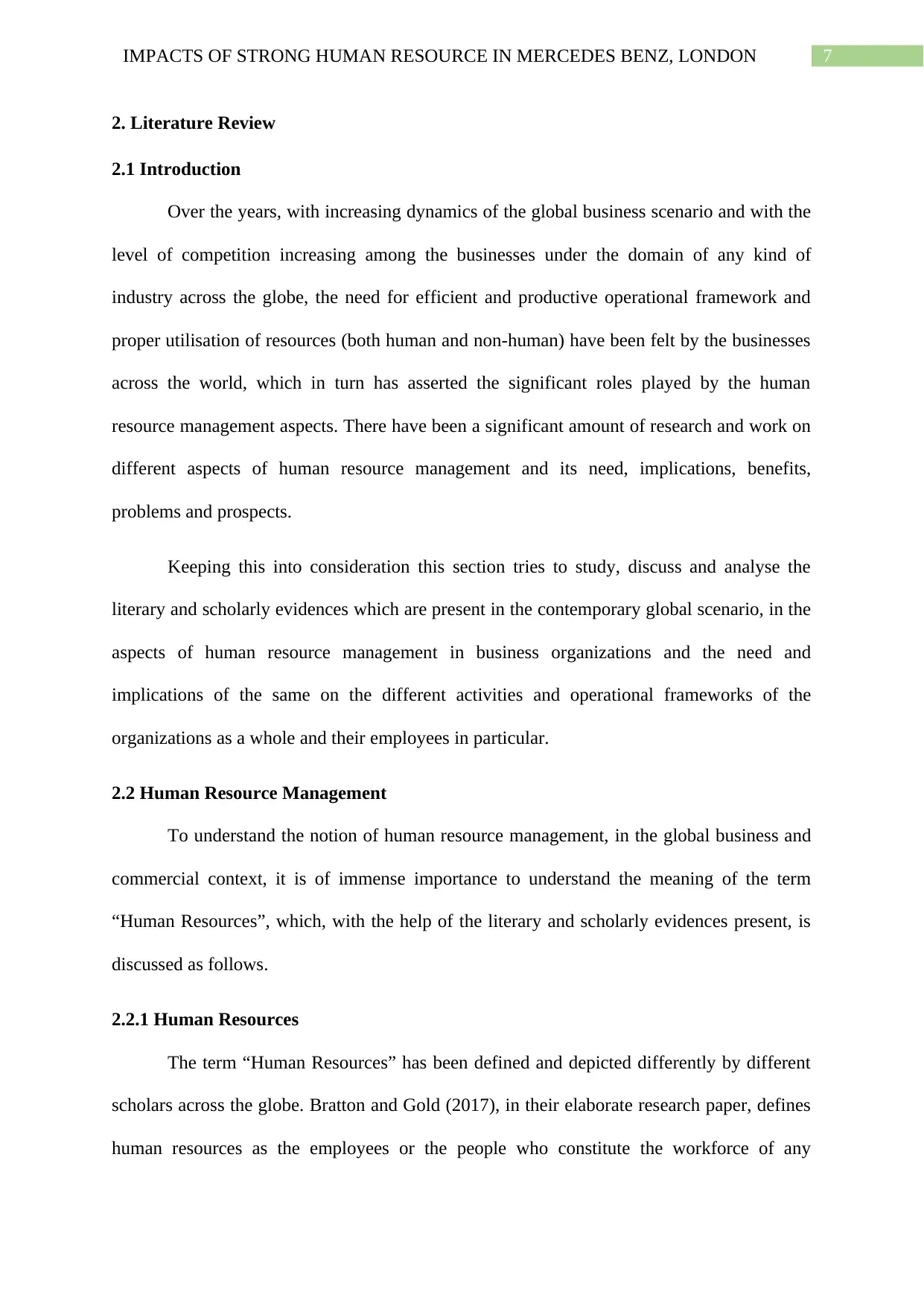
7IMPACTS OF STRONG HUMAN RESOURCE IN MERCEDES BENZ, LONDON
2. Literature Review
2.1 Introduction
Over the years, with increasing dynamics of the global business scenario and with the
level of competition increasing among the businesses under the domain of any kind of
industry across the globe, the need for efficient and productive operational framework and
proper utilisation of resources (both human and non-human) have been felt by the businesses
across the world, which in turn has asserted the significant roles played by the human
resource management aspects. There have been a significant amount of research and work on
different aspects of human resource management and its need, implications, benefits,
problems and prospects.
Keeping this into consideration this section tries to study, discuss and analyse the
literary and scholarly evidences which are present in the contemporary global scenario, in the
aspects of human resource management in business organizations and the need and
implications of the same on the different activities and operational frameworks of the
organizations as a whole and their employees in particular.
2.2 Human Resource Management
To understand the notion of human resource management, in the global business and
commercial context, it is of immense importance to understand the meaning of the term
“Human Resources”, which, with the help of the literary and scholarly evidences present, is
discussed as follows.
2.2.1 Human Resources
The term “Human Resources” has been defined and depicted differently by different
scholars across the globe. Bratton and Gold (2017), in their elaborate research paper, defines
human resources as the employees or the people who constitute the workforce of any
2. Literature Review
2.1 Introduction
Over the years, with increasing dynamics of the global business scenario and with the
level of competition increasing among the businesses under the domain of any kind of
industry across the globe, the need for efficient and productive operational framework and
proper utilisation of resources (both human and non-human) have been felt by the businesses
across the world, which in turn has asserted the significant roles played by the human
resource management aspects. There have been a significant amount of research and work on
different aspects of human resource management and its need, implications, benefits,
problems and prospects.
Keeping this into consideration this section tries to study, discuss and analyse the
literary and scholarly evidences which are present in the contemporary global scenario, in the
aspects of human resource management in business organizations and the need and
implications of the same on the different activities and operational frameworks of the
organizations as a whole and their employees in particular.
2.2 Human Resource Management
To understand the notion of human resource management, in the global business and
commercial context, it is of immense importance to understand the meaning of the term
“Human Resources”, which, with the help of the literary and scholarly evidences present, is
discussed as follows.
2.2.1 Human Resources
The term “Human Resources” has been defined and depicted differently by different
scholars across the globe. Bratton and Gold (2017), in their elaborate research paper, defines
human resources as the employees or the people who constitute the workforce of any
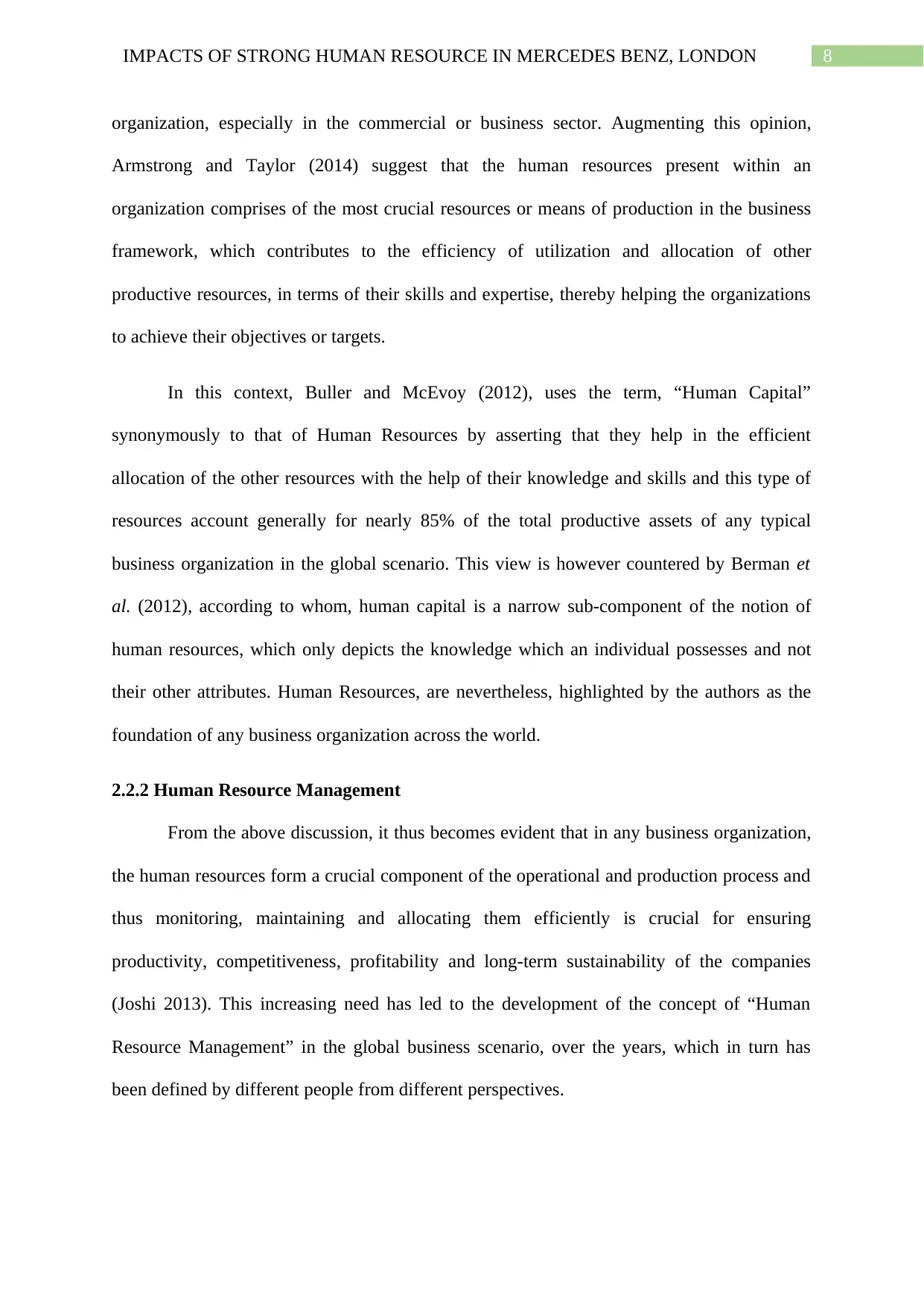
8IMPACTS OF STRONG HUMAN RESOURCE IN MERCEDES BENZ, LONDON
organization, especially in the commercial or business sector. Augmenting this opinion,
Armstrong and Taylor (2014) suggest that the human resources present within an
organization comprises of the most crucial resources or means of production in the business
framework, which contributes to the efficiency of utilization and allocation of other
productive resources, in terms of their skills and expertise, thereby helping the organizations
to achieve their objectives or targets.
In this context, Buller and McEvoy (2012), uses the term, “Human Capital”
synonymously to that of Human Resources by asserting that they help in the efficient
allocation of the other resources with the help of their knowledge and skills and this type of
resources account generally for nearly 85% of the total productive assets of any typical
business organization in the global scenario. This view is however countered by Berman et
al. (2012), according to whom, human capital is a narrow sub-component of the notion of
human resources, which only depicts the knowledge which an individual possesses and not
their other attributes. Human Resources, are nevertheless, highlighted by the authors as the
foundation of any business organization across the world.
2.2.2 Human Resource Management
From the above discussion, it thus becomes evident that in any business organization,
the human resources form a crucial component of the operational and production process and
thus monitoring, maintaining and allocating them efficiently is crucial for ensuring
productivity, competitiveness, profitability and long-term sustainability of the companies
(Joshi 2013). This increasing need has led to the development of the concept of “Human
Resource Management” in the global business scenario, over the years, which in turn has
been defined by different people from different perspectives.
organization, especially in the commercial or business sector. Augmenting this opinion,
Armstrong and Taylor (2014) suggest that the human resources present within an
organization comprises of the most crucial resources or means of production in the business
framework, which contributes to the efficiency of utilization and allocation of other
productive resources, in terms of their skills and expertise, thereby helping the organizations
to achieve their objectives or targets.
In this context, Buller and McEvoy (2012), uses the term, “Human Capital”
synonymously to that of Human Resources by asserting that they help in the efficient
allocation of the other resources with the help of their knowledge and skills and this type of
resources account generally for nearly 85% of the total productive assets of any typical
business organization in the global scenario. This view is however countered by Berman et
al. (2012), according to whom, human capital is a narrow sub-component of the notion of
human resources, which only depicts the knowledge which an individual possesses and not
their other attributes. Human Resources, are nevertheless, highlighted by the authors as the
foundation of any business organization across the world.
2.2.2 Human Resource Management
From the above discussion, it thus becomes evident that in any business organization,
the human resources form a crucial component of the operational and production process and
thus monitoring, maintaining and allocating them efficiently is crucial for ensuring
productivity, competitiveness, profitability and long-term sustainability of the companies
(Joshi 2013). This increasing need has led to the development of the concept of “Human
Resource Management” in the global business scenario, over the years, which in turn has
been defined by different people from different perspectives.
⊘ This is a preview!⊘
Do you want full access?
Subscribe today to unlock all pages.

Trusted by 1+ million students worldwide
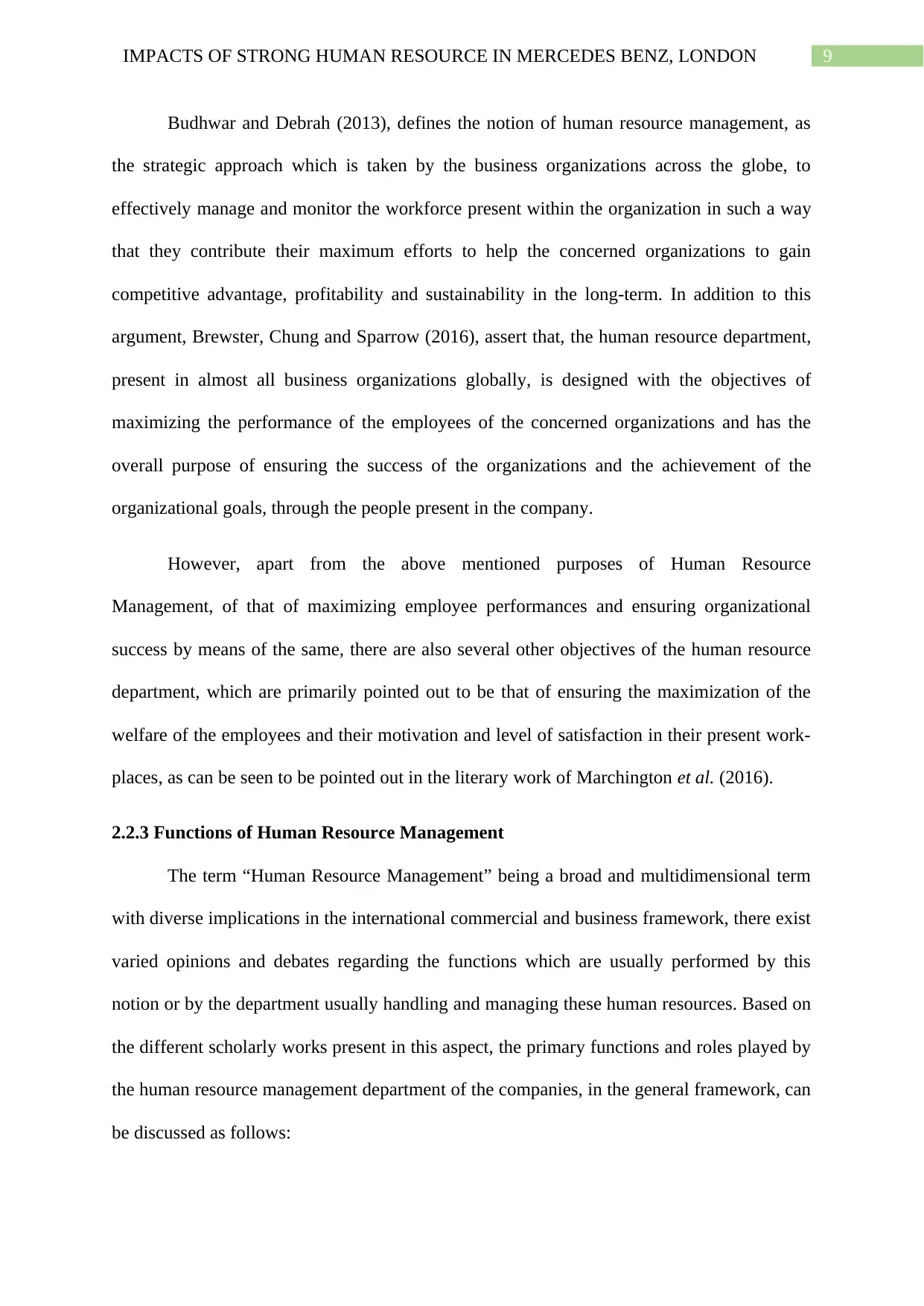
9IMPACTS OF STRONG HUMAN RESOURCE IN MERCEDES BENZ, LONDON
Budhwar and Debrah (2013), defines the notion of human resource management, as
the strategic approach which is taken by the business organizations across the globe, to
effectively manage and monitor the workforce present within the organization in such a way
that they contribute their maximum efforts to help the concerned organizations to gain
competitive advantage, profitability and sustainability in the long-term. In addition to this
argument, Brewster, Chung and Sparrow (2016), assert that, the human resource department,
present in almost all business organizations globally, is designed with the objectives of
maximizing the performance of the employees of the concerned organizations and has the
overall purpose of ensuring the success of the organizations and the achievement of the
organizational goals, through the people present in the company.
However, apart from the above mentioned purposes of Human Resource
Management, of that of maximizing employee performances and ensuring organizational
success by means of the same, there are also several other objectives of the human resource
department, which are primarily pointed out to be that of ensuring the maximization of the
welfare of the employees and their motivation and level of satisfaction in their present work-
places, as can be seen to be pointed out in the literary work of Marchington et al. (2016).
2.2.3 Functions of Human Resource Management
The term “Human Resource Management” being a broad and multidimensional term
with diverse implications in the international commercial and business framework, there exist
varied opinions and debates regarding the functions which are usually performed by this
notion or by the department usually handling and managing these human resources. Based on
the different scholarly works present in this aspect, the primary functions and roles played by
the human resource management department of the companies, in the general framework, can
be discussed as follows:
Budhwar and Debrah (2013), defines the notion of human resource management, as
the strategic approach which is taken by the business organizations across the globe, to
effectively manage and monitor the workforce present within the organization in such a way
that they contribute their maximum efforts to help the concerned organizations to gain
competitive advantage, profitability and sustainability in the long-term. In addition to this
argument, Brewster, Chung and Sparrow (2016), assert that, the human resource department,
present in almost all business organizations globally, is designed with the objectives of
maximizing the performance of the employees of the concerned organizations and has the
overall purpose of ensuring the success of the organizations and the achievement of the
organizational goals, through the people present in the company.
However, apart from the above mentioned purposes of Human Resource
Management, of that of maximizing employee performances and ensuring organizational
success by means of the same, there are also several other objectives of the human resource
department, which are primarily pointed out to be that of ensuring the maximization of the
welfare of the employees and their motivation and level of satisfaction in their present work-
places, as can be seen to be pointed out in the literary work of Marchington et al. (2016).
2.2.3 Functions of Human Resource Management
The term “Human Resource Management” being a broad and multidimensional term
with diverse implications in the international commercial and business framework, there exist
varied opinions and debates regarding the functions which are usually performed by this
notion or by the department usually handling and managing these human resources. Based on
the different scholarly works present in this aspect, the primary functions and roles played by
the human resource management department of the companies, in the general framework, can
be discussed as follows:
Paraphrase This Document
Need a fresh take? Get an instant paraphrase of this document with our AI Paraphraser
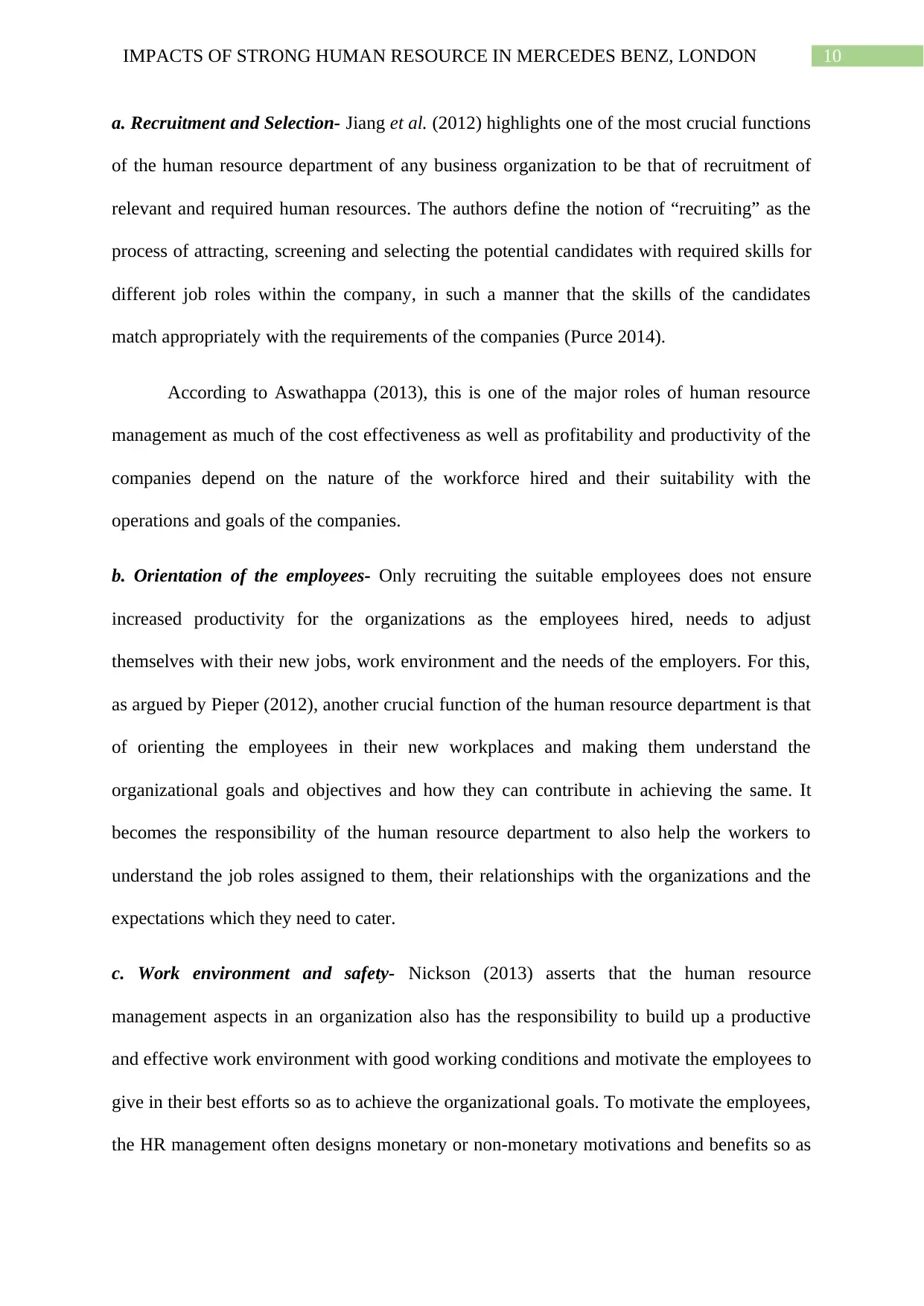
10IMPACTS OF STRONG HUMAN RESOURCE IN MERCEDES BENZ, LONDON
a. Recruitment and Selection- Jiang et al. (2012) highlights one of the most crucial functions
of the human resource department of any business organization to be that of recruitment of
relevant and required human resources. The authors define the notion of “recruiting” as the
process of attracting, screening and selecting the potential candidates with required skills for
different job roles within the company, in such a manner that the skills of the candidates
match appropriately with the requirements of the companies (Purce 2014).
According to Aswathappa (2013), this is one of the major roles of human resource
management as much of the cost effectiveness as well as profitability and productivity of the
companies depend on the nature of the workforce hired and their suitability with the
operations and goals of the companies.
b. Orientation of the employees- Only recruiting the suitable employees does not ensure
increased productivity for the organizations as the employees hired, needs to adjust
themselves with their new jobs, work environment and the needs of the employers. For this,
as argued by Pieper (2012), another crucial function of the human resource department is that
of orienting the employees in their new workplaces and making them understand the
organizational goals and objectives and how they can contribute in achieving the same. It
becomes the responsibility of the human resource department to also help the workers to
understand the job roles assigned to them, their relationships with the organizations and the
expectations which they need to cater.
c. Work environment and safety- Nickson (2013) asserts that the human resource
management aspects in an organization also has the responsibility to build up a productive
and effective work environment with good working conditions and motivate the employees to
give in their best efforts so as to achieve the organizational goals. To motivate the employees,
the HR management often designs monetary or non-monetary motivations and benefits so as
a. Recruitment and Selection- Jiang et al. (2012) highlights one of the most crucial functions
of the human resource department of any business organization to be that of recruitment of
relevant and required human resources. The authors define the notion of “recruiting” as the
process of attracting, screening and selecting the potential candidates with required skills for
different job roles within the company, in such a manner that the skills of the candidates
match appropriately with the requirements of the companies (Purce 2014).
According to Aswathappa (2013), this is one of the major roles of human resource
management as much of the cost effectiveness as well as profitability and productivity of the
companies depend on the nature of the workforce hired and their suitability with the
operations and goals of the companies.
b. Orientation of the employees- Only recruiting the suitable employees does not ensure
increased productivity for the organizations as the employees hired, needs to adjust
themselves with their new jobs, work environment and the needs of the employers. For this,
as argued by Pieper (2012), another crucial function of the human resource department is that
of orienting the employees in their new workplaces and making them understand the
organizational goals and objectives and how they can contribute in achieving the same. It
becomes the responsibility of the human resource department to also help the workers to
understand the job roles assigned to them, their relationships with the organizations and the
expectations which they need to cater.
c. Work environment and safety- Nickson (2013) asserts that the human resource
management aspects in an organization also has the responsibility to build up a productive
and effective work environment with good working conditions and motivate the employees to
give in their best efforts so as to achieve the organizational goals. To motivate the employees,
the HR management often designs monetary or non-monetary motivations and benefits so as
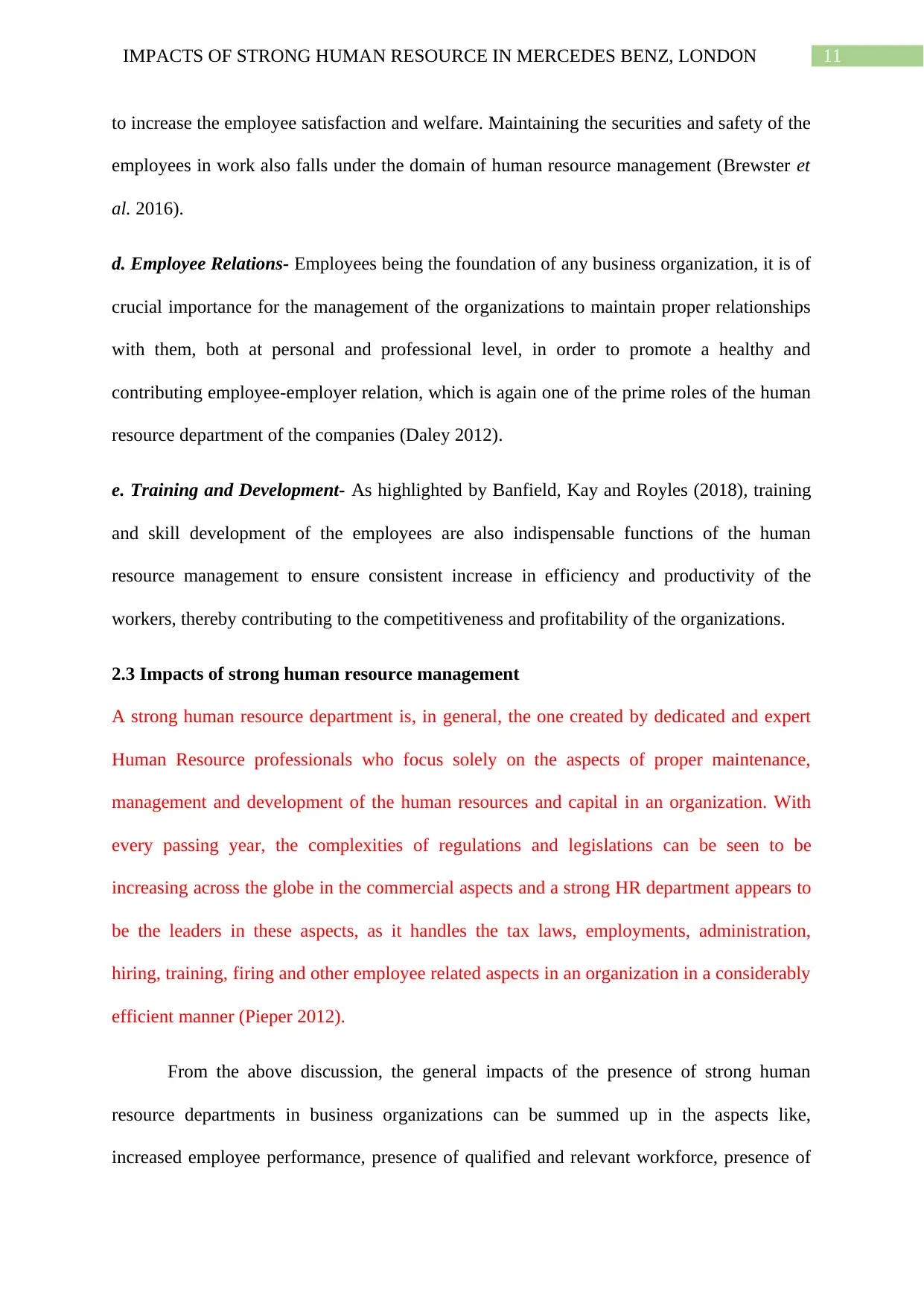
11IMPACTS OF STRONG HUMAN RESOURCE IN MERCEDES BENZ, LONDON
to increase the employee satisfaction and welfare. Maintaining the securities and safety of the
employees in work also falls under the domain of human resource management (Brewster et
al. 2016).
d. Employee Relations- Employees being the foundation of any business organization, it is of
crucial importance for the management of the organizations to maintain proper relationships
with them, both at personal and professional level, in order to promote a healthy and
contributing employee-employer relation, which is again one of the prime roles of the human
resource department of the companies (Daley 2012).
e. Training and Development- As highlighted by Banfield, Kay and Royles (2018), training
and skill development of the employees are also indispensable functions of the human
resource management to ensure consistent increase in efficiency and productivity of the
workers, thereby contributing to the competitiveness and profitability of the organizations.
2.3 Impacts of strong human resource management
A strong human resource department is, in general, the one created by dedicated and expert
Human Resource professionals who focus solely on the aspects of proper maintenance,
management and development of the human resources and capital in an organization. With
every passing year, the complexities of regulations and legislations can be seen to be
increasing across the globe in the commercial aspects and a strong HR department appears to
be the leaders in these aspects, as it handles the tax laws, employments, administration,
hiring, training, firing and other employee related aspects in an organization in a considerably
efficient manner (Pieper 2012).
From the above discussion, the general impacts of the presence of strong human
resource departments in business organizations can be summed up in the aspects like,
increased employee performance, presence of qualified and relevant workforce, presence of
to increase the employee satisfaction and welfare. Maintaining the securities and safety of the
employees in work also falls under the domain of human resource management (Brewster et
al. 2016).
d. Employee Relations- Employees being the foundation of any business organization, it is of
crucial importance for the management of the organizations to maintain proper relationships
with them, both at personal and professional level, in order to promote a healthy and
contributing employee-employer relation, which is again one of the prime roles of the human
resource department of the companies (Daley 2012).
e. Training and Development- As highlighted by Banfield, Kay and Royles (2018), training
and skill development of the employees are also indispensable functions of the human
resource management to ensure consistent increase in efficiency and productivity of the
workers, thereby contributing to the competitiveness and profitability of the organizations.
2.3 Impacts of strong human resource management
A strong human resource department is, in general, the one created by dedicated and expert
Human Resource professionals who focus solely on the aspects of proper maintenance,
management and development of the human resources and capital in an organization. With
every passing year, the complexities of regulations and legislations can be seen to be
increasing across the globe in the commercial aspects and a strong HR department appears to
be the leaders in these aspects, as it handles the tax laws, employments, administration,
hiring, training, firing and other employee related aspects in an organization in a considerably
efficient manner (Pieper 2012).
From the above discussion, the general impacts of the presence of strong human
resource departments in business organizations can be summed up in the aspects like,
increased employee performance, presence of qualified and relevant workforce, presence of
⊘ This is a preview!⊘
Do you want full access?
Subscribe today to unlock all pages.

Trusted by 1+ million students worldwide
1 out of 23
Related Documents
Your All-in-One AI-Powered Toolkit for Academic Success.
+13062052269
info@desklib.com
Available 24*7 on WhatsApp / Email
![[object Object]](/_next/static/media/star-bottom.7253800d.svg)
Unlock your academic potential
Copyright © 2020–2025 A2Z Services. All Rights Reserved. Developed and managed by ZUCOL.





